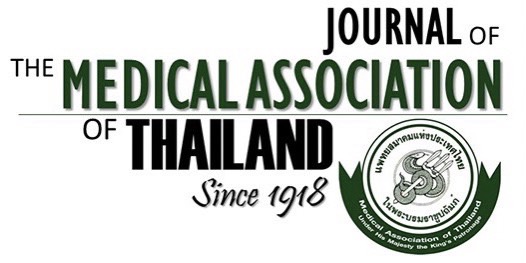Prevalence of Diabetic Foot Ulcers and Risk Classifications in Type 2 Diabetes Mellitus Patients at Rajavithi Hospital
Veerasak Sarinnapakorn MD*, Thongkum Sunthorntepwarakul MD*, Chaicharn Deerochanawong MD*, Sathit Niramitmahapanya MD*, Navaporn Napartivaumnuay MD*
Affiliation : * Division of Endocrinology, Department of Medicine, Rajavithi Hospital, College of Medicine, Rangsit University, Bangkok, Thailand
Background : Diabetic foot ulcers are a major cause of non-traumatic lower limb amputation in patients with type 2 diabetes.
In 2014, the Diabetes Association of Thailand issued new guidelines for classifying type 2 diabetes patients’ levels of risk of
developing foot ulcers, but no research on the prevalence of type 2 diabetes using these new classification criteria had been
performed prior to the current study.
Objective : To study the prevalence of diabetic foot ulcers overall and in different risk groups in type 2 diabetes mellitus
patients in Rajavithi Hospital, and to evaluate risk factors of these groups and correlations with ankle brachial index (ABI)
and cardio-ankle vascular index (CAVI).
Material and Method: 593 type 2 diabetes patients at Rajavithi Hospital were studied and classified into risk groups based
on the classification criteria issued by the Thailand Diabetes Association in 2014. ABI measurements were taken from 132
patients, and measurements of CAVI were taken from 101 patients.
Results : The prevalence of foot ulcers was 3.4% and 2.2% of patients had a history of amputation. The percentages of patients
at low, intermediate and high risk of developing foot ulcers were 55.8%, 33.6% and 10.6%, respectively. Age, duration of
diabetes, estimated glomerular filtration rate (eGFR), history of hypertension, dyslipidemia, nephropathy, cardiovascular
disease (CVA), deformity of foot, numbness, abnormal protective sensation, pulse deficit, ulcer, and amputation were factors
significantly associated with a high risk of foot ulcers (p<0.05), but fasting plasma glucose (FPG) and HbA1c were not
significant factors. There was an association between cerebrovascular accident and abnormal ABI.
Conclusion : Nearly half of these type 2 diabetes patients were in the groups with an intermediate or high risk of developing
foot ulcers. Screening of patients at risk of foot ulceration is necessary in order to classify patients into risk groups and
provide appropriate education, as well as proper monitoring and management.
Keywords : Foot ulcer, Type 2 diabetes, ABI, CAVI



